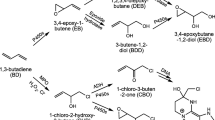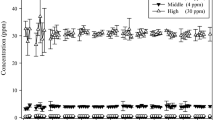Abstract
Gas uptake studies were carried out to evaluate kinetic interactions between 1,3-butadiene and styrene in Sprague-Dawley rats. The animals were co-exposed by inhalation to a mixture of 1,3-butadiene between 20 and 6000 ppm (v/v) and styrene between 0 and 500 ppm. The data demonstrate that metabolism of 1,3-butadiene was partialy inhibited by styrene. The inhibition was competitive at atmospheric concentrations of styrene up to 90 ppm. Higher concentrations of styrene resulted in a small additional inhibition only. The apparent Michaelis-Menten constant for 1,3-butadiene, related to the average concentration in the organism of the animals, was Kmapp = 1.17±0.37 (Μmol/l of tissue) and the corresponding atmospheric concentration at steady state was 560 ppm. The inhibition constant of styrene was found to be Ki = 0.23±0.30 (Μmol/l of tissue). The maximal metabolic rate for 1,3-butadiene was 230±10 (Μ/kg/h).
Similar content being viewed by others
References
Bolt H, Filser J, Störmer F (1984) Inhalation pharmacokinetics based on gas uptake studies. V. Comparative pharmacokinetics of ehtylene and 1,3-butadiene in rats. Arch Toxicol 55: 213–218
Conti B, Maltoni C, Perino G, Ciliberti A (1988) Long-term cancerogenicity bioassays on styrene administered by inhalation, ingestion and injection and styrene oxide administered by ingestion in Sprague-Dawley rats and para-methylstyrene administered by ingestion in Sprague-Dawley rats and Swiss mice. Ann NY Acad Sci 534: 203–234
Csanády G, Laib R (1992) Metabolic transformation of halogenated and other alkenes — a theoretical chemical approach. t J Quant Biol (submitted)
Filser J (1992) The closed chamber technique — uptake, endogenous production, excretion, steady-state kinetics and rates of metabolism of gases and vapours. Arch Toxicol 66: 1–10
Filser J, Bolt H (1979) Pharmacokinetics of halogenated ethylenes in rats. Arch Toxicol 42: 123–136
Filser J, Bolt H (1984) Inhalation pharmacokinetics based on gas uptake studies. VI Comparative evaluation of ethylene oxide and butadiene monoxide as exhaled reactive metabolites of ethylene and 1,3-butadiene in rats. Arch Toxicol 55: 219–223
Filser J, Kessler W, Koch R, Denk B, Summer K (1988) Kompetitive Hemmung der Bildung des n-Hexan-Metaboliten 2,5-Hexandion durch Toluol: Messung von Pyrrolen im Urine von Ratten. Verhandlungen der Deutschen Gesellschaft für Arbeitsmedizin e.V., 28. Jahrestagung, Innsbruck, Gentner Verlag Stuttgart
Garrison J, Bruice T (1989) Intermediates in the epoxidation of alkenes by cytochrome P-450 models. J Am Chem Soc 111: 191–198
Gesundheitsschädliche Arbeitsstoffe (1987) MAK-Begründung “Stymi”. In: Gesundheitsschädliche Arbeitsstoffe: Toxikologisch-arbeitsmedizinische Begründung von MAK-Werten, VCH-Verlaggesellschaft, Weinheim
Guengerich F (1991) Oxidation of toxic and carcinogenic chemicals by human cytochrome P-450 enzymes. Chem Res Toxicol 4: 391–407
Guengerich F, Liebler D (1985) Enzymatic activation of chemicals to toxic metabolites. CRC Crit Rev Toxicol 14: 259–307
Hartung J, Elpelt B, Klösner K (1989) Statistik. R. Oldenburg Verlag, München-Wien
Kessler W, Denk B, Filser J (1989) Species-specific inhalation pharmacokinetics of 2-nitropropane, methyl-ethyl-ketone and n-hexane. In: Travis C (ed) Biologically-based methods for cancer risk assessment. Plenum Publishing Corporation, New York, pp 123–139
Kreiling R, Laib R, Filser J, Bolt H (1986) Species differences in butadiene metabolism between mice and rats evaluated by inhalation pharmacokinetics. Arch Toxicol 58: 235–238
Levin L (1990) Functional diversity of hepatic cytochromes P-450. Drug Metab Dispos 18: 824–830
Löf A, Gullstrand E, Lundgren E, Byfält Nordquist M (1984) Occurrence of styrene-7,8-oxide and styrene glycol in mouse after the administration of styrene. Scand J Work Environ Health 10: 179–187
Maltoni C, Ciliberti A, Di Maio V (1977) Carcinogenicity bioassays on rats of acrylonitrile administered by inhalation and by ingestion. Med Lavoro 68: 401–411
Matanoski G, Santos-Burgoa C, Zeger S, Schwartz L (1989) Epidemiologic data related to health effects of 1,3-butadiene. In: Mohr U (ed) Assessment of inhalation hazards. Springer Verlag, Berlin, Heidelberg, New York, London, Paris, Tokyo, Hongkong, pp 201–214
Melnick R, Huff J, Miller R (1989) Toxicology and carcinogenicity of 1,3-butadiene. In: Mohr U (ed) Assessment of inhalation hazards. Springer Verlag, Berlin, Heidelberg, New York, London, Paris, Tokyo, Hongkong, pp 177–188
Normandeau J, Chakarabarti S, Brodeur J (1984) Influence of simultaneous exposure to acrylonitrile and styrene on the toxicity and metabolism of styrene in rats. Toxicol Appl Pharmacol 75: 346–349
Owen P, Glaister J, Gaunt I, Pullinger D (1987) Inhalation toxicity studies with 1,3-butadiene. 3. Two year toxicity/carcinogenicity study in rats. Am Ind Hyg Assoc J 48: 407–413
Ramsey J, Andersen M (1984) A physiologically based description of the inhalation pharmacokinetics of inhaled styrene in human volunteers. Toxicol Appl Pharmacol 73: 159–175
Roberts A, Lacy S, Pilon D, Turner M, Rickert D (1988) Metabolism of acrylonitrile to 2-cyanoethylene oxide in F-344 rat liver microsomes, lung microsomes and lung cells. Drug Metab Dispos 17: 481–486
Schwegler U (1991) Pharmakokinetic von Styrol bei Ratte und Maus. GSF-Bericht 15/91. GSF — Forschungszentrum für Umwelt und Gesundheit, Neuherberg
Schwegler U, Jiang X, Kessler W, Johanson G, Filser J (1990) Pharmakokinetic von Styrol by Ratte und Maus und Bestimmung von Styrol-7,8-oxid im Blut von Ratten. Verhandlungen der Deutschen Gesellschaft für Arbeitsmedizin e. V., 28. Jahrestagung, Genter Verlag Stuttgart
Stryer L (1979) Biochemie. Friedr. Vieweg & Sohn Verlagsgesellschaft mbH., Braunschweig
Suzuki T, Shimbo S, Nishitani S (1974) Muscular atrophy due to glue sniffing. Int Arch Arbeitsmed 33: 115–123
Author information
Authors and Affiliations
Additional information
On leave from Central Research Institute of Chemistry, Hungarian Academy of Sciences, Budapest, Hungary
Rights and permissions
About this article
Cite this article
Laib, R.J., Tucholski, M., Filser, J.G. et al. Pharmacokinetic interaction between 1,3-butadiene and styrene in Sprague-Dawley rats. Arch Toxicol 66, 310–314 (1992). https://doi.org/10.1007/BF01973624
Received:
Accepted:
Issue Date:
DOI: https://doi.org/10.1007/BF01973624




